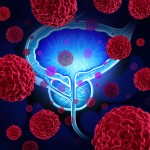Prostate cancer is the second most common cancer in men worldwide, with an estimated 1.1 million cases occurring in 2012 resulting in 307,000 deaths. In developed nations, prostate cancer is increasingly being diagnosed when the tumor is still confined to the prostate, partly due to screening with prostate specific antigen (PSA).
Screening for prostate cancer with PSA became widely adopted into clinical practice by the early 1990 s. There are ongoing controversies regarding this particular screening test.
Standard treatment approaches include active surveillance, radical prostatectomy, external beam radiotherapy and brachytherapy. Patients are risk stratified according to the TNM staging (Tumor, Nodes, Metastasis) and for low-risk patients with localized disease active surveillance is an option; the goal being to avert treatment-related complications.
Currently, the accepted form of treatment for more advanced prostate cancer is radiation therapy along with androgen deprivation therapy (ADT / chemical castration). Some patients may opt for radical prostatectomy in lieu of radiotherapy.
It should be noted that any form of treatment that is not either surgery or radiation -- such as chemotherapy, hormone therapy, immunotherapy -- is considered adjuvant therapy. "Neoadjuvant therapy refers to treatment given prior to the main treatment.
There are two forms of radiotherapy in prostate cancer patients. The first is External Beam Radiation Therapy (EBRT) and the second is Brachytherapy (brachy is Greek for short distance). EBRT delivers a beam or several beams of high energy x-rays to a patient s tumor. The beams are focused on the tumor while sparing the normal surrounding tissues. Brachytherapy involves the placement of radioactive seeds within the tumor or near the tumor exposing high dose radiation to the tumor and decreased radiation to surrounding normal tissue.
ADT aims to suppress the level of male hormones known as androgens (main ones are testosterone and dihydrotestosterone). Prostate cancer is largely dependent upon androgen, at least initially, for its continued growth. The testes produce 90 to 95 percent of total circulating testosterone, whereas, the other five to 10 percent are produced by the adrenal glands.
A new study published in Science Translational Medicine discusses how treatment of patients with chemical castration prior to radiotherapy has proven more effective than radiotherapy alone. Radiotherapy alone requires the cells to be in a particular phase of the cell cycle (when DNA replication and growth occur).
For intermediate- and high-risk prostate cancer, chemical castration plus radiotherapy has become the standard of care in many treatment centers, as it has shown to improve long-term local control of the tumor and survival of patients.
The premise behind radiation therapy is that it very effectively damages the DNA of tumor cells. The most toxic form of DNA damage occurs in the form of double-stranded breaks (the structure of DNA is similar to a twisted ladder), and the only way this can be repaired is via non-homologous end joining (NHEJ). This is a repair mechanism that is dependent on a protein known as Ku-70. Chemical castration serves as a primer for radiation therapy as it blocks Ku-70 from binding to androgen receptors on the cell that activate the cellular repair engine. Chemical castration also reduces the amount of Ku-70 present in cells. Basically, chemical castration needs to happen before radiotherapy because it enhances the cancer-killing effect.
The authors feel that that the inhibition of DNA repair by cells (as exemplified by the effects of chemical castration) is a feature that may be exploited therapeutically by introducing chemotherapeutic drugs into the treatment regimen that interfere with DNA repair mechanisms. They also note that Ku-70 may not be the only protein involved in repairing double-stranded breaks. This provides a further avenue of research into elucidating the androgen receptor-mediated DNA repair pathway.




